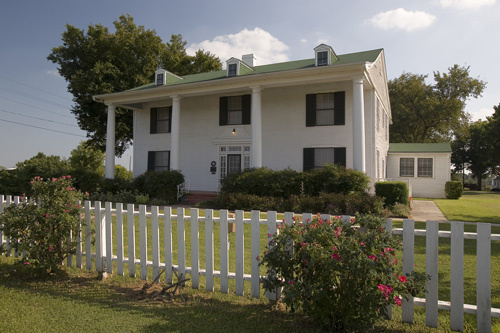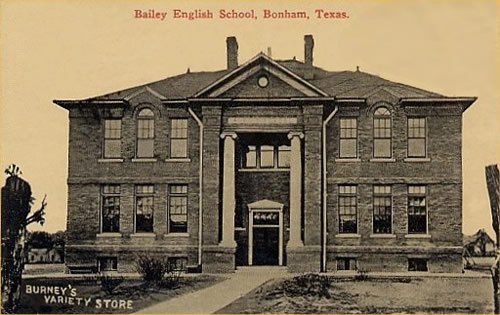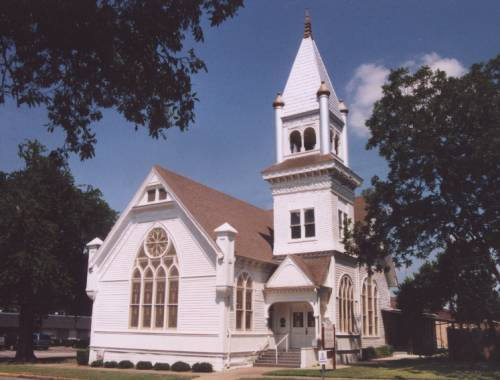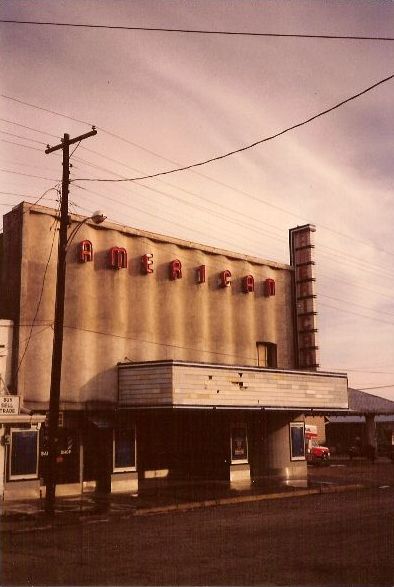Bonham, Texas, Fannin County seat. (original) (raw)
Bonham, Texas Attractions/Landmarks
and Photo Gallery

Sam Rayburn House
Sam Rayburn House Museum
Recorded Texas Historic Landmark - 1965
Photo courtesy TxHC at English Wikipedia
Historical Marker: 890 W. Hwy 56
Sam Rayburn House
In 1916, three years after he began his career in the U.S. Congress, Sam Rayburn built this home for his parents, who had left their farm at Windom. The 2-story house had a front porch on each floor. In 1934 architect W. B. Yarborough enlarged "The Home Place," turning the porches into a 2-story portico. When not in Washington, Rayburn lived here with other members of the family. Deeded to the Texas Historical commission in 1972, the house is now (1974) a museum.
Recorded Texas Historic Landmark - 1965
- The Sam Rayburn House Museum:
Mr. Rayburn's residence built in 1916.
Original furnishings and personal items.
8 - 5 Tuesday-Friday and 9 - 5 on Sat.
Closed Sunday and Monday
(903) 583-5558
http://www.thc.state.tx.us.html Sam Rayburn's Home by Bob Bowman
"A visit to Bonham should start with a stop at the Sam Rayburn House Museum on U.S. Highway 82 on the west side of town."... more
- Sam Rayburn Library and Museum:
Just west of Downtown Bonham, the library contains memorabilia and furnishings from the Washington office of one of the country's most powerful and influential Speakers of the House. Second only to his personal friend LBJ, Rayburn was the most visible Texan in US Government, even surpassing Uvalde's "Cactus Jack" Gardner who was FDR's Vice President.
Monday through Friday 10 - 5, Saturday 1 - 5, Sunday 2 - 5.
903-583-2455 Historical Marker: 800 W. Sam Rayburn Drive
Sam Rayburn Library and Museum
Speaker Sam Rayburn and Dallas architect Roscoe DeWitt designed this facility to house Sam Rayburn's archives, books and artifacts. Rayburn served Fannin and surrounding counties for more than 55 years as state legislator and U.S. Congressman, including 17 years as Speaker of the House. The library, built in 1955-57, reflects the Classical Revival architecture of federal buildings in Washington, D.C. The steel construction building features a marble fa�ade, copper roof, and Ionic columns supporting an entablature at the main entrance. The building also includes an exact replica of the Speaker's office.
Recorded Texas Historic Landmark - 2008
- Clyde W. Cosper Texas State Veterans Home
1300 Seven Oaks Road, Bonham, Texas.Lt. Clyde "Sparky" Cosper by John Troesser - Fannin County Museum:
One Main Street
903-583-8042.
Hours: September to March Tuesday through Saturday noon to 4.
April to August Tuesday through Saturday 10 to 4.
Formerly on the third floor of the courthouse, the Museum now resides in the restored Texas and Pacific Railroad Depot. - Fort Inglish Park:
A replica of the original settlement in 1837 that eventually became Bonham.
W. Sam Rayburn Drive.
903-583-3441. - Bonham State Park
Less than 4 miles from Bonham - Coffee Mill Lake:
Off FM 409.
15 miles northeast of Bonham.
Caddo National Grassland Wildlife Management AreaBook Hotel Here › Bonham Hotels

Victorian Architecture in Bonham
Photo courtesy Barclay Gibson, April 2006

Bonham, Texas Old Photos

High School, Bonham, Texas
Postcard courtesy www.rootsweb.com/ %7Etxpstcrd/

Bailey English School, Bonham, Texas
Postcard courtesy www.rootsweb.com/ %7Etxpstcrd/

High School, Bonham, Texas
Postcard courtesy www.rootsweb.com/ %7Etxpstcrd/
More Texas Schoolhouses

Hospital, Bonham, Texas, 1908
Postcard courtesy www.rootsweb.com/ %7Etxpstcrd/
 |
Bonham Texas postcard, circa 1907 |
|---|
Bonham Chronicles:
- James Bonham - The Alamo's brave messenger by Murray Montgomery
- Lt. Clyde "Sparky" Cosper by John Troesser
B-17 Pilot, 367th Bomber Group, Hometown: Dodd City, Texas
"A B-17 crashed near the town of Princes Risborough, Buckinghamshire, England on November 13, 1943. The only thing that prevented the plane from landing directly on the town, was the Herculean effort of the man at the controls....." - MacPhelan Reese, Sam Rayburn, and the Rayburn Library by Mike Cox
- Savoy Male and Female College by Mike Cox ("Texas Tales")
When graduates of the long-extinct Savoy Male and Female College gathered for their first reunion in 1938, several of the men did a little reminescing about the Indians fights they had back in the day... - Flagpole by Mike Cox ("Texas Tales")
This story is about a mystery involving the flag staff that once stood at Camp Howze, a sprawling World War II Army base at Gainesville... - Tom Bean by John Troesser
- The Hardin Brothers by Bob Bowman ("All Things Historical")
More than 110 years have passed since East Texas outlaw John Wesley Hardin was shot down in an El Paso saloon, but he remains one of the most intriguing badmen in history... John Wesley, named for the founder of Methodism, was born at Bonham in Fannin County on May 26, 1853...
Bonham, Texas Historical Markers
Historical Marker: Willow Wild Cemetery (near W. 10th & SH 121)
Sam Rayburn
(Jan. 16, 1882 - Nov. 16, 1961)
Tennessee native Sam Taliaferro Rayburn moved to Texas with his family in 1887. His long and successful political career began with his election to the Texas Legislature in 1906. It continued through 25 consecutive terms in the U. S. House of Representatives, where Rayburn served with 8 presidents and held the speakership for 17 years. His funeral at the First Baptist Church in Bonham was attended by 30,000 people, including 4 presidents and 105 Congressmen.
1986
Historical Marker: corner of Sam Rayburn & Chinner St.; in front of Fort Inglish Museum
Bailey Inglish
(ca. 1797-1867)
In 1837, Bailey Inglish moved his family to this area from western Arkansas, where he had been an influential leader of pioneer settlers. Here he was active in the formation of Fannin County, serving on the land board and later as chief justice. To guard against repeated Indian raids, he built a fort on his land for area residents. The settlement that developed, first know as Bois d'Arc, became Bonham. Inglish was instrumental in its early growth through active public service and donations of land for town lots, a cemetery, and a female seminary.
Texas Sesquicentennial 1836-1986
Historical Marker: Center (SH 78) & 8th St.
First Baptist Church
Organized November 1852 under the Rev. J. R. Briscoe with six charter members. The first log church on this site doubled as the school. Cost of this lot-- then outside city limits -- was $50. Indian trail lay northeast. In 1855 a new frame church was built; baptisms were held in Saunder's pool on West 7th. Other denominations were also allowed to worship here. New churches were built in 1882 and 1921, the latter being dedicated by George W. Truett, noted evangelist. The present church was dedicated 1959 under the Rev. Jack M. Carson, pastor.
1968
Historical Marker: 1201 N. Main St., L. H. Rather Junior High School
Bonham High School Auditorium and Gymnasium
Using funds from the Federal Public Works Administration and local tax dollars, this structure was built to provide space for school and community assemblies, performances and athletic events. Architects Voelcker and Dixon of Wichita Falls designed the auditorium with Romanesque influences in its arched window and entrance openings and its brick detailing. The 1937 Junior-Senior prom was the first official school function held here, followed later that school year by commencement exercises in the auditorium. It remains in use for community functions.
Recorded Texas Historic Landmark - 2001
Historical Marker: 1 Main St., Fannin County Museum of History
Bonham Cotton Mill
In 1900, nine Bonham businessmen formed a corporation to construct and operate a cotton mill near this site. The town's presence on the northern edge of the blackland prairie made it an ideal location for textile manufacturing, since cotton was one of the area's principal crops. The Bonham Cotton Mill, which opened in 1901, was the town's first significant industrial plant. The corporation constructed a series of company homes and provided free day care for children of employees. In 1920, the company merged with Consolidated Textile Corporation, which was based on the east coast. Management of the mill remained in the hands of John C. Saunders until his death in 1934. The Bonham Cotton Mill closed in 1930 with the onset of the Great Depression. In 1931, Bonham businessmen rechartered it as a Texas corporation. After reaching its peak of production during the 1940s, the cotton mill declined in the post-World War II years. The plant merged with the Brenham Cotton Mill in 1958 but closed eventually in the 1970s. As Bonham's principal employer for many years of the 20th century, the cotton mill had a major impact on the city's social and economic history.
Texas Sesquicentennial 1836-1986
Historical Marker: 314 N. Center St.
Bonham Daily Favorite
In 1887 Dr. J. M. Terry, who gave up medicine for journalism, established the "Weekly Fannin Favorite." He expanded in 1892 by starting this newspaper, the oldest daily publication in Fannin County. For 45 years its offices were in the 500 block of North Main before moving here in 1953. Although ownership has changed many times, the award-winning newspaper has maintained high standards of news coverage. The "Daily Favorite" recorded the public career of Sam Rayburn (1882-1961), Congressman from this district and longtime Speaker of the U.S. House of Representatives.
1978
Historical Marker: near Lynn Street entrance
Inglish Cemetery
(1838-1964)
County's oldest. Bailey Inglish donated plot near old Fort Inglish (called Bois d'Arc, later Bonham). Pioneers buried here include 1838 Indian massacre victims Andrew Daugherty, Wm. McCarty; 1836 Fannin County colonizers Bailey Inglish and Daniel Rowlett; and Texas Revolution veterans James Tarleton.
Fannin County Historical Survey Committee, 1964.
Historical Marker: corner of 10th & N. Main St.
On Route of Early Texas Streetcars
In Bonham--as in most Texas towns that became busy trading, ranching, or agricultural centers in the late 1800s--streetcars or trolleys were used in local transit. Bonham's steam-powered streetcar line, built about 1890, extended 2.5 miles from Russell Heights to the Texas & Pacific Railroad Station. Cars ran every 30 minutes. Fare was 5 cents; or 10 cents round-trip. The route avoided the business district, as streetcars frightened horses and disrupted trading. Other towns of sprawling growth had mule-drawn streetcars as early as 1875. These early cars were susceptible to track-jumping, collision, and other accidents, but were nevertheless welcomed for their services. Convenient streetcar rides attracted not only townspeople, but saddle-sore cowboys as well. By 1890, when Bonham acquired the steam-car line, mule-drawn cars were being replaced all over Texas.
1967
Texas Escapes, in its purpose to preserve historic, endangered and vanishing Texas, asks that anyone wishing to share their local history, stories, landmarks and recent or vintage photos, please contact us.



